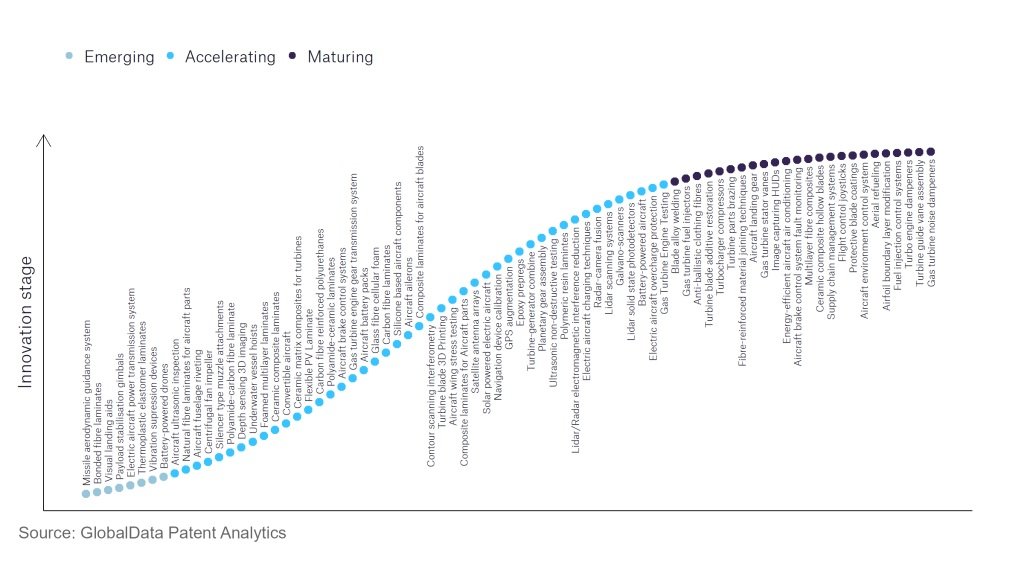The aerospace and defence industry continues to be a hotbed of innovation, with activity driven by the need to lower operational costs, larger consumer trends, and electrification, and the growing importance of technologies such as hydrogen and electric aircraft and advanced materials.
In the last three years alone, there have been over 174,000 patents filed and granted in the aerospace and defence industry, according to GlobalData’s report on Environment Sustainability in Aerospace, Defence & Security: Reformer integrated fuel cells.
However, not all innovations are equal and nor do they follow a constant upward trend. Instead, their evolution takes the form of an S-shaped curve that reflects their typical lifecycle from early emergence to accelerating adoption, before finally stabilising and reaching maturity.
Identifying where a particular innovation is on this journey, especially those that are in the emerging and accelerating stages, is essential for understanding their current level of adoption and the likely future trajectory and impact they will have.
More than 180 innovations will shape the industry
According to GlobalData’s Technology Foresights, which plots the S-curve for the aerospace and defence industry using innovation intensity models built on over 262,000 patents, there are 180+ innovation areas that will shape the future of the industry.
Within the emerging innovation stage, hydrogen fuel cells, aircraft powertrain control, and fuel cells for aircraft are disruptive technologies that are in the early stages of application and should be tracked closely.
EV charging stations, hybrid propulsion aircraft engines, and electric aircraft charging interfaces are some of the accelerating innovation areas, where adoption has been steadily increasing. Among maturing innovation areas are fuselage frame modelling and powered wheels for aircraft landing, which are now well-established in the industry.
Innovation S-curve for the aerospace and defence industry

Protective blade coatings is a key innovation area
Various coatings can be applied to turbine blades to protect them, which reduces downtime due to faults. These coatings can have several applications, such as thermal barriers and water and dust repellents.
GlobalData’s analysis also uncovers the companies at the forefront of each innovation area and assesses the potential reach and impact of their patenting activity across different applications and geographies.
According to GlobalData, there are more than 10 companies, spanning technology vendors, established aerospace and defence companies, and up-and-coming start-ups engaged in the development and application of protective blade coatings.
Key players in protective blade coatings – a disruptive innovation in the aerospace and defence industry
‘Application diversity’ measures the number of different applications identified for each relevant patent and broadly splits companies into either ‘niche’ or ‘diversified’ innovators.
‘Geographic reach’ refers to the number of different countries each relevant patent is registered in and reflects the breadth of geographic application intended, ranging from ‘global’ to ‘local’.
Patent volumes related to protective blade coatings
General Electric is one of the leading patent filers in protective blade coatings. The company has submitted patents relating to icephobic protective coatings for blades, as well as infiltration coatings and reactive phase spray formulation coatings. Some other key patent filers include Rolls-Royce, Safran, and Raytheon Technologies.
In terms of geographic reach, IHI leads the pack, followed by General Motors and JGC in the second and third positions, respectively. Regarding application diversity, Applied Thin Films holds the top position, followed by General Motors, Honeywell International, CDP Equity, and General Electric.
Protective blade coatings have both commercial and military applications. Patent filings aren’t limited to aerospace and defence companies. However, aerospace and defence companies have a significant presence as some of the largest patent filers for this technology, including companies such as General Electric, Rolls-Royce, Safran, and Raytheon Technologies.
To further understand the key themes and technologies disrupting the aerospace and defence industry, access GlobalData’s latest thematic research report on Defence.
GlobalData, the leading provider of industry intelligence, provided the underlying data, research, and analysis used to produce this article.
GlobalData’s Patent Analytics tracks patent filings and grants from official offices around the world. Textual analysis and official patent classifications are used to group patents into key thematic areas and link them to specific companies across the world’s largest industries.